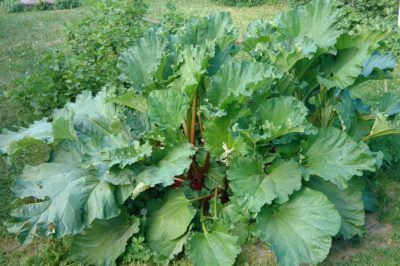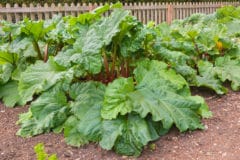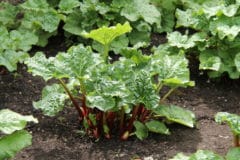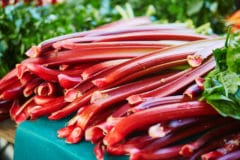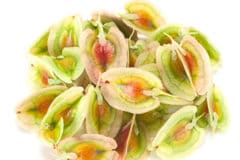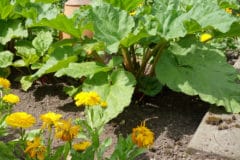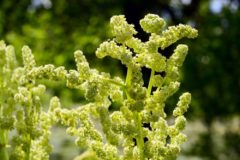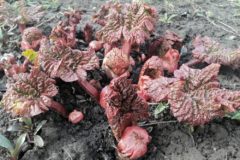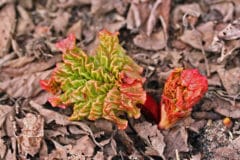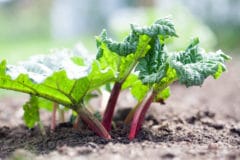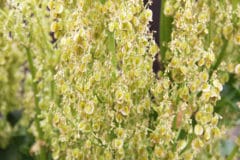Plant Protection
The purpose of those big leaves on your rhubarb is to protect your plant. As rhubarb requires a great deal of water to thrive, especially in warm weather, the leaves provide shade for the roots and help keep them moist. The cover provided by the leaves also prevents heat damage to the root system.
Keeping your plant well fed, with compost, manure, or organic fertilizer will ensure big, strong leaves capable of hiding your plants from the sun’s hot, drying rays.
When the weather is harsh and stormy, those rhubarb leaves do service, too. Large and thick and strong, they protect the ground and the plant’s roots from damaging heavy rains, hail, and even wind-blown debris.
Bug Beater
As mentioned above, the rhubarb leaf contains a toxic compound, oxalic acid. This is actually good for the plant, though, as oxalic acid is not only bad for people, but for insects. Because of this, the leaves protect the plant from bugs, yet the poison in the leaves is not found in the stalks, so they’re completely safe to eat.
For this same reason, rhubarb can be a fantastic companion for other plants in your garden. Planting rhubarb near food plants that experience insect infestations can help keep those plants safe from damage.
Complete Composting
Surprisingly, rhubarb leaves are fine for your compost. The process of decomposition completely breaks down the oxalic acid in the leaves, making them safe to use in your garden. Simply cut them off your harvested stalks and add them to your compost pile to nourish next year’s crop.
Don’t forget that when you have kept your rhubarb plant well fed, the leaves have been nourished too. When composted, they will put those nutrients back into your finished product.
In addition to being great for composting, rhubarb leaves can serve as an excellent mulch. These leaves can grow quite large, which makes them perfect for laying over the ground to hold moisture in and protect the roots of your rhubarb and other plants.
You can shred or cut them if you want to, but laying these leaves down whole will help keep your garden’s plants protected. You’ll notice that rhubarb leaves tend to break down and decompose quickly, so be sure to replace them as needed. Just as with composting, the process of breaking down eliminates the toxins in the leaves, so they’re safe to use in your garden.
Other Options
- Some people have been known to use rhubarb leaves to make an organic pesticide, too. By steeping rhubarb leaves in a large pot of boiling water, then straining the liquid from the plant matter and diluting it, you will have a natural pesticide for your garden. It is advised that you not use this close to harvest time as the oxalic acid needs time to break down.
- Rhubarb leaves can be used to impress their lovely vein and leave pattern on do-it-yourself concrete stepping stones, too. Stones made with the patterns of leaves and flowers are an excellent complement to your yard or garden, and the pattern of a rhubarb leaf is particularly suited to making a great impression.
- Artisans who like to make fabric dye from plants and vegetables can find that these colors fade or wash away quickly. The oxalic acid in rhubarb leaves can be used as a “mordant,” or setting solution for these natural dyes. Check at your local craft or textile store for information on creating dyes and using rhubarb leaves to set the colors.
- Burned something messy in a favorite pan? Many report that boiling a couple of rhubarb leaves in the pot will break loose the burned mess and restore your pan to normal. It’s advised that you wash the pan well after this treatment to be sure all the oxalic acid is off of the cooking surface.
These are just a few of the potential uses for your rhubarb leaves. And whether you choose to use them to clean, eliminate garden pests, create art, or to nourish and protect other plants, these big, fancy leaves can serve many uses.
One caveat, though. Be sure to wash your hands thoroughly after handling rhubarb leaves. You’re not likely to pick up much in the way of oxalic acid, but it’s always better to be cautious when handling toxins of any sort.
